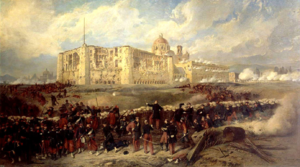
Back Franse inval in Meksiko Afrikaans الحرب الفرنسية المكسيكية Arabic Eil emelladenn Bro-C'hall e Mec'hiko Breton Segona intervenció francesa a Mèxic Catalan Francouzská intervence v Mexiku Czech Französische Intervention in Mexiko German Segunda intervención francesa en México Spanish جنگ فرانسه و مکزیک Persian Expédition du Mexique French המלחמה הפרנקו-מקסיקנית HE
| History of Mexico |
|---|
 |
| Timeline |
|
|
The second French intervention in Mexico (Spanish: segunda intervención francesa en México), also known as the Second Franco-Mexican War (1861–1867),[5] was a military invasion of the Republic of Mexico by the French Empire of Napoleon III, purportedly to force the collection of Mexican debts in conjunction with Great Britain and Spain. Mexican conservatives supported the invasion, since they had been defeated by the liberal government of Benito Juárez in a three-year civil war. Defeated on the battlefield, conservatives sought the aid of France to effect regime change and establish a monarchy in Mexico, a plan that meshed with Napoleon III's plans to re-establish the presence of the French Empire in the Americas. Although the French invasion displaced Juárez's Republican government from the Mexican capital and the monarchy of Archduke Maximilian was established, the Second Mexican Empire collapsed within a few years. Material aid from the United States, whose four-year civil war ended in 1865, invigorated the Republican fight against the regime of Maximilian, and the 1866 decision of Napoleon III to withdraw military support for Maximilian's regime accelerated the monarchy's collapse.
The intervention came as a civil war, the Reform War, had just concluded, and the intervention allowed the Conservative opposition against the liberal social and economic reforms of President Juárez to take up their cause once again. The Catholic Church, conservatives, much of the upper-class and Mexican nobility, and some indigenous communities invited, welcomed and collaborated with the French empire to install Maximilian as Emperor of Mexico.[6] The emperor himself however proved to be of liberal inclination and continued some of the Juárez government's most notable measures. Some liberal generals defected to the empire, including the powerful, northern governor Santiago Vidaurri, who had fought on the side of Juárez during the Reform War.
The French army landed in January 1862, aiming to rapidly take the capital of Mexico City, but Mexican republican forces defeated them in the Battle of Puebla on 5 May 1862 ("Cinco de Mayo"), delaying their march on the capital for a year. The French and Mexican Imperial Army captured much of Mexican territory, including major cities, but guerrilla warfare by republicans remained a significant factor and Juárez himself never left the national territory. The intervention was increasingly using up troops and money at a time when the recent Prussian victory over Austria was inclining France to give greater military priority to European affairs. The liberals also never lost the official recognition of the United States of America in spite of their ongoing civil war, and following the defeat and surrender of the Confederate States of America in April 1865 the reunited country began providing material support to the republicans. Invoking the Monroe Doctrine, the U.S. government asserted that it would not tolerate a lasting French presence on the continent. Facing a mounting combination of domestic political discontent, diplomatic pressure and the growing military threat of Prussia on the borders of Metropolitan France itself, French units in Mexico began to redeploy to Europe in 1866. Without substantial French support, the Second Mexican Empire collapsed in 1867. Maximilian and the two conservative generals Miguel Miramón and Tomás Mejía were executed by firing squad on 19 June 1867, ending this period of Mexican history.[6]
- ^ Gustave Niox (1874). Expédition du Mexique, 1861–1867; récit politique & militaire (in French). Paris: J. Dumaine. ASIN B004IL4IB4. Retrieved 10 June 2020.
- ^ Conaway, William J. (2010). A Gringo Guide to Mexican History. William J Conaway. ISBN 978-0976580577.
- ^ Miller, Robert Ryal (2015). Mexico: A History. University of Oklahoma Press. ISBN 978-0806175270.
- ^ Clodfelter 2017, p. 305.
- ^ known in France as Expédition du Mexique at the time and today as Intervention française au Mexique
- ^ a b Kohn, George Childs, ed. (2007). Dictionary of Wars (3rd ed.). New York: Facts on File. p. 329. ISBN 978-1-4381-2916-7. OCLC 466183689.
